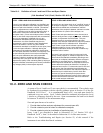
EPA Calibration Protocol Teledyne API – Model T300/T300M CO Analyzer
238
year. Each agency must audit 25% of the reference or equivalent analyzers each quarter.
If an agency operates less than four reference or equivalent analyzers, it must randomly
select analyzers for reauditing so that one analyzer will be audited each calendar quarter
and each analyzer will be audited at least once a year.
Appendix B, 40 CFR 58
5
requires that each Prevention of Significant Deterioration
(PSD) reference or equivalent analyzer be audited at least once a sampling quarter.
Results of these audits are used to estimate the accuracy of ambient air data.
10.4.2. DATA REDUCTION AUDIT
A data reduction audit involves transcribing analyzer data and determining if the
collected data is within the control limits, generally 2 ppm between the analyzer
response and the audit value. The resulting values are recorded on the SAROAD form.
If data exceeds 2 ppm, check all
of the remaining data in the 2-week period.
10.4.3. SYSTEM AUDIT/VALIDATION
A system audit is an on-site inspection and review of the quality assurance activities
used for the total measurement system (sample collection, sample analysis, data
processing, etc.); it is an appraisal of system quality.
Conduct a system audit at the startup of a new monitoring system and periodically (as
appropriate) as significant changes in system operations occur.
10.5. DYNAMIC MULTIPOINT CALIBRATION PROCEDURE
10.5.1. LINEARITY TEST
In order to record the instrument’s performance at a predetermined sensitivity and to
derive a calibration relationship, a minimum of three reference points and one zero point
uniformly spaced covering 0 to 90 percent of the operating range are recommended to
define this relationship.
The analyzer's recorded response is compared with the known concentration to derive
the calibration relationship.
To perform a precision check during the instrument set up, the sources of zero air and
sample gas should conform to those described in Section 9.1.1.3.
Follow the pr
ocedures described in Section 9.3 for cal
ibrating the zero points.
06864B DCN6314


















